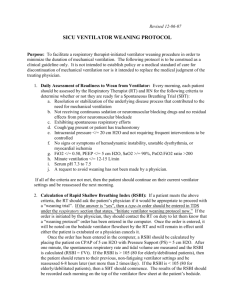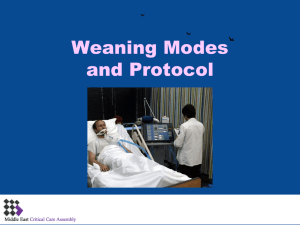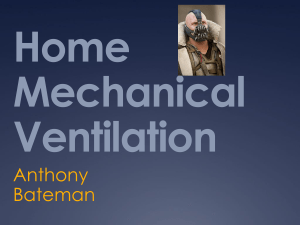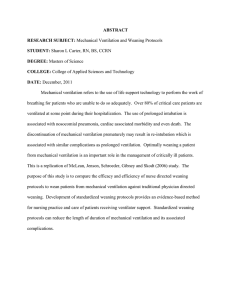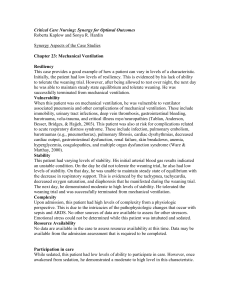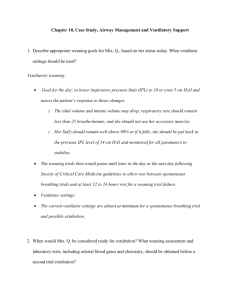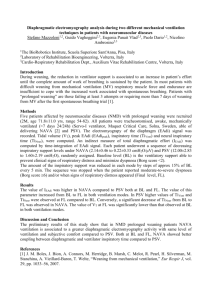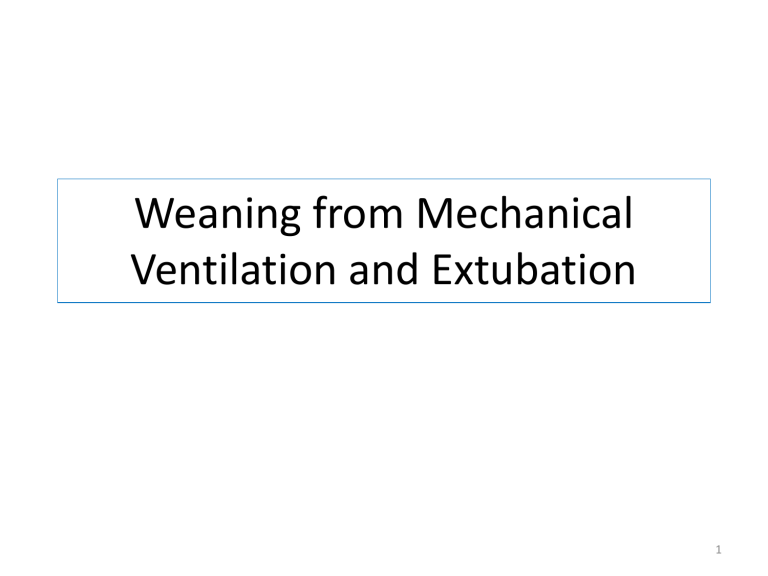
Weaning from Mechanical Ventilation and Extubation 1 Objectives • Identify different methods of titrating support during weaning • Factors to consider when weaning • Identify the recommendations for weaning developed by the AARC guidelines • Identify when to abort a SBT • Identify when a patient is ready for extubation • Identify and treat post extubation difficulties 2 Objectives • Identify appropriate strategies, management and goals when a patient has failed an SBT 3 Methods of Titrating Support During Weaning • Support can be reduced as patient’s become increasingly able to resume part of the work of breathing • Three traditional methods: – SIMV – PSV – T piece weaning • Closed loop ventilation 4 Methods of Titrating Support During Weaning- SIMV • SIMV – Theory underlying is that the patient’s muscles would work during breaths spontaneous and rest during mandatory breaths. – Reduce rate progressively, 1-2 breaths at a time – PSV from 5-10 can be added- esp. important as the rate is reduced – In reality the respiratory muscles perform significant work in both spontaneous and mandatory breaths 5 Methods of Titrating Support During Weaning- PSV • PSV- patient controls the rate, timing, and depth of each breath • Patient triggered, pressure limited, flow cycled • Set PSV– level that accomplishes a reasonable ventilatory pattern -usually PSV is 5- 15 cmH2O – Level that reestablished baseline RR and VT 6 Methods of Titrating Support During Weaning- PSV • Gradually reduce PSV as long as RR and Vt is maintained and pt has no signs of distress • Once PSV is reduced to 5 cmH2O, PS is just to overcome work imposed by the ventilator system 7 Methods of Titrating Support During Weaning- T - Piece Trial • Oldest form available • Advantage to accomplish through the vent – alarms • Disadvantage- increased workload 8 Methods of Titrating Support During Weaning • No one method is more superior than the other • If one method doesn’t‘ work, another may 9 Evaluation of Weaning Attempt A patient who appears to be ready for discontinuation of ventilatory support is being weaned with SIMV. The data below indicate the patient's progress. No PSV or CPAP is used to support spontaneous breaths. (Pilbeam and Cairo, Susan P., J.M.. Mechanical Ventilation, 4th Edition. C.V. Mosby, 022006. p. 446). 10 • 80% of patients do not require a slow withdrawal process and can be removed within a few hours or days from support. – Post Op – Drug Overdose – Exacerbations of Asthma 11 Factors to consider • Some will require support during weaning • O2 and Peep • Some may require artificial airway after vent is withdrawn • Some need all of the above 12 Where does all this rational come from? 1999-The Federal Agency for Healthcare Policy and Research asked the McMaster University Outcomes Research Unit to perform comprehensive review of literature on ventilator withdrawal. Task force used this review to create evidence-based guidelines for weaning for patients that require more than 24 hours of ventilator support. AARC and Resp. Care Journal 2002. 13 What is the first thing that we need to consider before we begin weaning attempts? a. b. c. d. FiO2 Rate Whether the underlying problem is resolved None of the above 14 Recommendation 1. In patients requiring mechanical ventilation for > 24 hours, a search for all the causes that may be contributing to ventilator dependence should be undertaken. This is particularly true in the patient who has failed attempts at withdrawing the mechanical ventilator. Reversing all possible ventilatory and nonventilatory issues should be an integral part of the ventilator discontinuation process. 15 Is the Respiratory Failure Resolved? • • • • • Neurological Respiratory Factors Metabolic and Ventilatory Muscle Function Cardiovascular Factors Psychological Factors Even if the patient’s disease that led to ventilation has improved or reversed, still need to consider overall condition 16 Recommendation 2. Patients receiving mechanical ventilation for respiratory failure should undergo a formal assessment of discontinuation potential if the following criteria are satisfied: • Evidence for some reversal of the underlying cause of respiratory failure; • Adequate oxygenation .requiring positive end-expiratory pressure [PEEP] < 8 cm H2O; FIO2 < 0.5) and pH (eg, > or = 7.25); • Hemodynamic stability • The capability to initiate an inspiratory effort. • Sedation vacation • GCS >8 • Afebrile 17 Criteria • • • • • • • • PEEP < or = 8 cm H2O; FIO2 < or = 0.5 pH > or = 7.25 Hemodynamic stability The capability to initiate an inspiratory effort. Sedation vacation GCS >8 Afebrile Although these tell us about potential for a successful discontinuation, assessments made during a 30-120 minute SBT may be the most useful guide for making a decision about discontinuation 18 Weaning criteria • Stable, spontaneously breathing and alert. • 75% of patients who meet criteria tolerate an initial trial of SBT • 30% who never satisfy criteria are successfully weaned • No single measure has been established that is uniformly successful in predicting a patient’s “weanability.” 19 Recommendation 3. • Formal discontinuation assessments should be done during spontaneous breathing rather than while the patient is still receiving substantial ventilatory support. • An initial brief period of spontaneous breathing should be used to assess the capability of continuing onto a formal SBT. • During the SBT assess the patient’s respiratory pattern, adequacy of gas exchange, hemodynamic stability, and subjective comfort. • The tolerance of SBTs lasting 30 to 120 minutes should prompt consideration for permanent ventilator discontinuation. 20 Weaning criteria- During SBT • Muscle strength – – – – VC >15ml/kg or > 1.0 lpm Ve <10 l/min TV > 250 or = 5-8 ml/kg f 8-20 • Dependant on patients disease process – Ventilatory pattern is synchronous and stable – NIF = -20 or greater – RSBI = <105 (f/VT) 77%-85% of patients who pass an SBT can beweaned and extubated without requiring reintubation 21 SBT • SBT lasts at least 30 minutes but not more than 120 minutes • low level of CPAP – e.g. 5 cm H2O • Low level PSV- e.g. 5-8 cm H2O • T piece • Auto Tube Compensation • All provide good results 22 Signs that patient is failing SBT • RR > 30-35 BPM (also watch for change greater than 10BPM or decrease to below 8) • VT < 250 mL (5- ml/kg) • Significant BP changes • HR increases 20% or exceeds 140 BP • Sudden onset PVC’s (more than 4-6 per minute) • Diaphoresis • Clinical signs- such as deteriorating ABG’s or saturations 23 You should consider ending an SBT under which of the following circumstances? A. The RR increases from 20 to 25 breaths per min B. The Vt decreases from 350 mL to 150 mL C. The systolic blood pressure decreases from 150 to 140 mm Hg D. The heart rate increases from 90 to 100 beats per min 24 Recommendation 4. • The removal of the artificial airway from a patient who has successfully been discontinued from ventilatory support should be based on assessments of airway patency and the ability of the patient to protect the airway. 25 Removal of Airway • Asses airway patency and ability to protect airway • Risks: – Aspiration – Inability to clear secretions – Unsuccessful Cuff Leak Test • Successful leak test does not guarantee that post-extubation difficulties will not arise. • 80% of patients that intentionally self-extubate do no need to be re intubated 26 Cuff Leak Test • To qualify- the patient must no longer NEED Ventilatory support – Cuff is deflated – A leak around the cuff during spontaneous breathing suggests that the airway is adequate and successful extubation is likely. 27 NiPPV • Beneficial for those who need some degree of support • Helps ease the transition from invasive ventilation to spontaneous breathing • Benefits: – Improves survival – Lowers Mortality rate – Reduces risk of nosocomial pneumonia – Shortens ICU and hospital stays 28 Criteria for NiPPV • Resolutions of problems leading to Respiratory Failure • Ability to tolerate SBT for 10-15 minutes • Strong cough reflex • Hemodynamic Stability • Minimal Secretions • Low O2 requirements • Optimum nutrition status Patient cooperation is key to success 29 Failed Weaning Attempt A 76-year-old man with a history of COPD has been on ventilatory support for 4 days, since he had a heart attack. The ventilator settings are: Vt = 700 mL; SIMV rate = 8 breaths/min; FIO2 = 0.5; PEEP/CPAP = 5 cm H2O. ABG results on these settings are: pH = 7.37; PaCO2 = 36 mm Hg; PaO2 = 78 mm Hg; SpO2 = 93%. The patient currently meets all criteria for weaning and is placed on a T-piece. Within 10 minutes he develops restlessness, tachycardia, rapid, shallow breathing, and diaphoresis. The SpO2 drops from 93% to 90%, and the pulmonary artery wedge pressure rises from 12 to 17 mm Hg. The patient does not complain of chest pain and has no dysrhythmias. What do you think is responsible for the failed weaning attempt? (Pilbeam and Cairo, Susan P., J.M.. Mechanical Ventilation, 4th Edition. C.V. Mosby, 022006. p. 463). 30 Weaning Failure 31 Recommendation 5. • Patients receiving mechanical ventilation for respiratory failure who fail an SBT should have the cause for the failed SBT determined. Once reversible causes for failure are corrected, and if the patient still meets the criteria listed in Table 3, subsequent SBTs should be performed every 24 hours. 32 Factors in Weaning Failure SBT should be performed every 24 hours once: 1. Reversible causes have been corrected AND 2. Patient still meets criteria for discontinuation Avoid pushing patient to point of exhaustion as it will only delay success 33 Factors in Weaning Failure, cont’d • Other causes of or complications – Inadequate pain control – Inappropriate sedation – Impaired fluid status – Need for Bronchodilator Therapy – Other disease processes (i.e., MI) 34 Factors in Weaning Failure, cont’d • Non- Respiratory Factors that may complicate weaning: – Cardiac Factors – Acid- Base Factors – Metabolic – Pharmacological Agents – Nutritional Status – Psychological Factors (See Table 20-2 on page 461.) 35 Recommendation 6. • Patients receiving mechanical ventilation for respiratory failure who fail an SBT should receive a stable, nonfatiguing, comfortable form of ventilatory support. 36 Maintain ventilation after SBT failure – Clinical focus for the 24 hours after a failed SBT is: 1. maintain adequate muscle unloading 2. optimizing comfort (sedation) 3. preventing complications 4. patient load needs to be non fatiguing Do not focus on aggressive ventilatory support reduction 37 Maintain ventilation after SBT failure, cont’d • When patient fails SBT, repeated testing the same day is no benefit • No evidence to support that gradual reduction strategy is better than providing full, stable support between once daily SBT’s • One finding of the task force was how poorly clinicians assess the potential for ventilator discontinuation, esp in patients considered ventilator dependent for longer than several days. • This emphasizes the need for more focused assessment strategies 38 The clinical focus for the 24 hours after a failed SBT should concentrate on all of the following EXCEPT: A. Optimizing Comfort B. Continuing to try and reduce ventilatory support C. Preventing Complications D. Maintain stable ventilation and not allow patient to fatigue 39 Recommendation 7. • Anesthesia/sedation strategies and ventilator management aimed at early extubation should be used in postsurgical patients. 40 Early extubation in post op patients 1. Focus needs to be early extubation in post-op patients 2. Ventilated primarily because of depressed respiratory drive and pain Due to the unreliable respiratory drive, utilize modes that guarantee a breathing rate and Ve. 41 Recommendation 8. • Weaning/discontinuation protocols designed for nonphysician health care professionals (HCPs) should be developed and implemented by ICUs. Protocols aimed at optimizing sedation should also be developed and implemented. 42 Weaning protocols • Development and implementation of therapist driven protocols (TDP’s) in ICU’s • TDP’s have been found to be safe and to reduce hospital costs by shortening the time required for ventilatory support • Significant drop in extubation failures and shorter weaning times when TDPs’ are used. • Studies suggest that physicians are way too Conservative when considering whether a patient is ready for SBT or extubation 43 44 All of the following are true for TDP protocols EXCEPT A. They shorten weaning time B. They significantly reduce extubation times C. Physicians are aggressive in starting SBT’s D. They are less costly than conventional weaning techniques 45 Recommendation 9. • Tracheostomy should be considered after an initial period of stabilization on the ventilator when it becomes apparent that the patient will require prolonged ventilator assistance. Tracheotomy should then be performed when the patient appears likely to gain one or more of the benefits ascribed to the procedure. 46 Tracheostomy’s Patients who may derive particular benefit from early tracheotomy are the following: 1. Patients need high levels of sedation to tolerate ET tubes 2. Patients have marginal respiratory efforts (often manifested as tachypnea) – a trach tube has lower resistance which can help reduce the WOB 3. Patients who will benefit from the ability to eat orally, enhanced communication (Speech), and have enhanced mobility; and 4. Patients in whom enhanced mobility may assist physical therapy efforts 47 Tracheostomy’s cont’d • Patients have less facial discomfort • Reduced WOB, deadspace and better secretion removal 48 Tracheotomy is most indicated for which of the following patients A. Those requiring low levels of sedation to tolerate ET B. Those with strong respiratory mechanics who rarely exhibit tachypnea C. Those who may gain psychological benefit from the ability to eat, talk and have greater mobility D. Those with good mobility and easy tolerance of physical therapy efforts 49 Recommendation 10. Unless there is evidence for clearly irreversible disease (eg, high spinal cord injury or advanced amyotrophic lateral sclerosis), a patient requiring prolonged mechanical ventilatory support for respiratory failure should not be considered permanently ventilatordependent until 3 months of weaning attempts have failed. 50 Ventilator Dependence Unless there is evidence of Irreversible disease (ALS, paralysis, etc.) a patient should not be considered “ventilator dependent” until 3 months have passed and all weaning attempts have failed. 51 Recommendation 11 • RT’s should be familiar with facilities in their communities, or units in hospitals they staff, that specialize in managing patients who are vent dependent • When medically stable for transfer, patients who have failed ventilator discontinuation attempts in the ICU should be transferred to those facilities that have shown that they are successful in accomplishing ventilator discontinuation. 52 Recommendation 12. • Weaning strategy in the long term patient should be slow-paced and should include gradually lengthening self-breathing trials. 53 Weaning the long term patient in long term facilities 1. Reduce amount of support 2. Reduce invasiveness of support 3. Increase independence 4. Preserve or improve current function 5. Maintain medical stability Protocols are usually individualized rather than fixed like in ICU. 54 Weaning the long term patient in long term facilities, cont’d. • Weaning is slow • Daily SBT’s are not performed because patients won’t be weaned successfully in 24 hours 55
